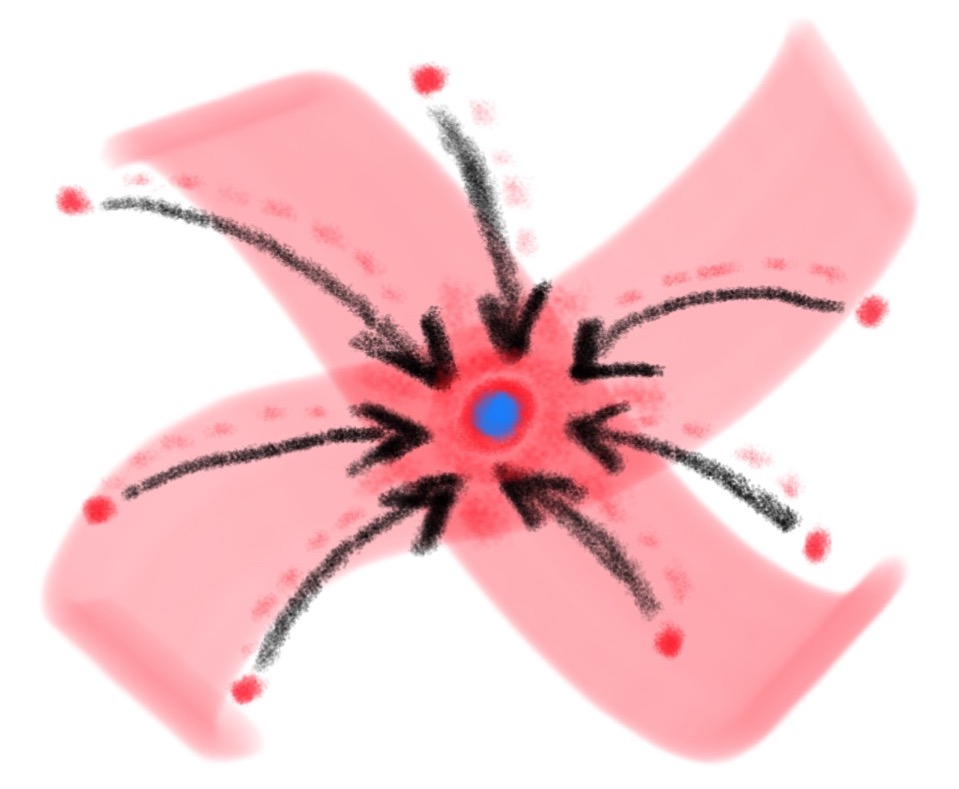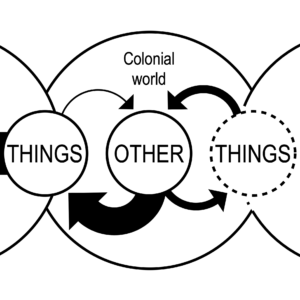Centralization is a spatial practice used by human collectives for thousands of years. It started in the archaic definition of village leaders and evolved to world empires, including their corollary transnational companies. Centralization promises to better organize society through the gathering of resources and information generated in a vast territory in a small space: the castle of the King, the metropolis, and the headquarters. From that vantage point, central leaders can redistribute resources and information where they are needed.

Historically, this promise is largely unfulfilled. As the resources and information start to flow inwards, central leaders take a toll over them, enjoy, and use all of that for their own interests, ultimately stopping worrying about the margins. Centralization produces excessive capital accumulation, generating political and economic instability.
In the past, instabilities were resolved through revolts and wars, but today they are resolved through reorganization. Information technology allows the reorganization of the State and transnational companies through networks with many centers, each exchanging the information and the resources they can get. Extraction is improved due to source proximity, but the centers’ center still accumulates power and capital.
Modern capitalist companies and States have found that they can hide this accumulation and reduce discontent through the periphery’s temporary inclusion within the center. Those who lived their entire lives at the margin, never being seriously considered by the center, are suddenly invited to participate in a central project, to make decisions, and, in some rare cases, benefit from its results. Nothing substantial changes in the spatial practice. When the project ends, the participant returns to the periphery with fewer advantages than those earned by the center. The periphery does not develop, as it still depends on the center.
User-centered design came about like this: technology companies disconnected from their user base needing to generate qualitative differentials for their products and services in saturated markets. As the philosopher Jesus Martín-Barbero describes, “it is an abstract inclusion and a concrete exclusion” because the users who participate in the project have no decision power. Users receive gifts or financial compensation for the time granted to the company, but there is no participation in the intellectual property created from their experience. It is an unfair exchange, similar to the exchange of land for a mirror proposed by the Portuguese to the indigenous people who lived in Brazil before the European colonization.
Switching “user” for “human” is six of one and half a dozen of the other. Switching “human” for “humanity” is homogenizing the world as if everybody had the same opportunities, which is definitely not the case at the periphery. The worst switch is to “non-humans”, “things”, and “more-than-humans”, totally ignoring the historical fight for humanity at the periphery. With this move, the center indirectly states that their artifacts, animals, and other living beings have more agency than the humans who live at the margins, especially if these non-humans are filled with materials, nutrients, and data extracted at the margins. In this case, they can even replace the less-than-human participant in representing the periphery. They seem to have more agency because they extend the centers’ power.
There is a growing movement in decolonizing design that addresses some of the issues raised here; however, the associated practices are not living up to the discourse. Decolonizing implies questioning the centralization strategy that justified colonization in the first place. Human-centered, BIPOC-centered, LGBT-centered, whatever-centered design tries to fit a discourse with an existing spatial practice that evolved precisely to generate the inequalities that are supposed to be countered. That is one of the reasons why most decolonizing design practices are surprisingly similar to colonizing design practices.
Previous decolonization movements started by cutting the periphery’s dependence from the center, through diplomacy or revolution. The second step was typically redistributing power, dismantling centralization. Rather than offering abstract promises of inclusion, decolonization built concrete infrastructures on top of the colonial legacy so that the periphery could develop autonomously. This is so different from what decolonizing design initiates are proposing, for example, recognizing understated design actors, celebrating indigenous aesthetics, generating social innovations, and other superficial changes that do not challenge the underlying spatial practices of modern society. These are all important, but decolonization must go deeper.
The research we are doing here in Brazil tells me that decolonization may advance through taking the means of production to the peripheries, giving up intellectual property and authorship, commoning resources and information, encouraging designing freedom, eschewing universal methods, reframing colonial legacies, and redefining design epistemologies. Once the focus change from accumulating capital to crafting relations, the center does not hold. Decentralized, distributed, or federated networks may apply but, like any colonial legacy, they need to come to terms with Indigenous spatial practices. With this short commentary, I suggest that decolonization needs alternatives to centralization more than refashioned metropolitan-centered designs that look good in the picture, that sell corporate workshops, that create job opportunities, and that, ultimately, end up improving capital accumulation at the metropolitan centers.

